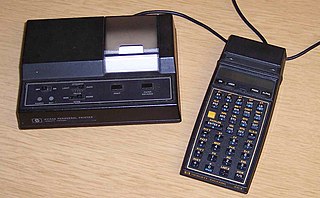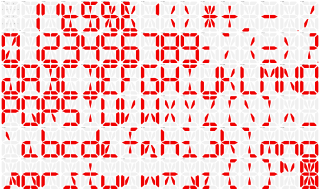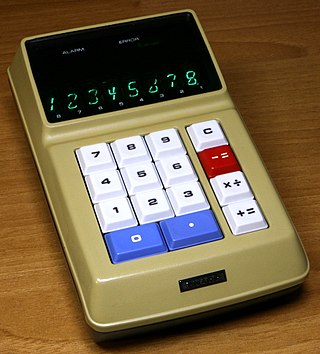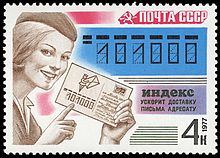
An electronic calculator is typically a portable electronic device used to perform calculations, ranging from basic arithmetic to complex mathematics.

A Nixie tube, or cold cathode display, is an electronic device used for displaying numerals or other information using glow discharge.
Although people in many parts of the world share common alphabets and numeral systems, styles of handwritten letterforms vary between individuals, and sometimes also vary systematically between regions.

A display device is an output device for presentation of information in visual or tactile form. When the input information that is supplied has an electrical signal the display is called an electronic display.

A vacuum fluorescent display (VFD) is a display device once commonly used on consumer electronics equipment such as video cassette recorders, car radios, and microwave ovens.

A seven-segment display is a form of electronic display device for displaying decimal numerals that is an alternative to the more complex dot matrix displays.

The HP-41C series are programmable, expandable, continuous memory handheld RPN calculators made by Hewlett-Packard from 1979 to 1990. The original model, HP-41C, was the first of its kind to offer alphanumeric display capabilities. Later came the HP-41CV and HP-41CX, offering more memory and functionality.
A fourteen-segment display (FSD) is a type of display based on 14 segments that can be turned on or off to produce letters and numerals. It is an expansion of the more common seven-segment display, having an additional four diagonal and two vertical segments with the middle horizontal segment broken in half. A seven-segment display suffices for numerals and certain letters, but unambiguously rendering the ISO basic Latin alphabet requires more detail. A slight variation is the sixteen-segment display which allows additional legibility in displaying letters or other symbols.

A sixteen-segment display (SISD) is a type of display based on sixteen segments that can be turned on or off to produce a graphic pattern. It is an extension of the more common seven-segment display, adding four diagonal and two vertical segments and splitting the three horizontal segments in half. Other variants include the fourteen-segment display which does not split the top or bottom horizontal segments, and the twenty-two-segment display that allows lower-case characters with descenders.

Handheld electronic games are interactive electronic games, often miniaturized versions of video games, that are played on portable handheld devices, known as handheld game consoles, whose controls, display and speakers are all part of a single unit. Rather than a general-purpose screen made up of a grid of small pixels, they usually have custom displays designed to play one game. This simplicity means they can be made as small as a smartwatch, and sometimes are. The visual output of these games can range from a few small light bulbs or LED lights to calculator-like alphanumerical screens; later these were mostly displaced by liquid crystal and vacuum fluorescent display screens with detailed images and in the case of VFD games, color. Handhelds' popularity was at its peak from the late 1970s into the early 1990s before declining. They are the precursors to the handheld game console.

A dot-matrix display is a low-cost electronic digital display device that displays information on machines such as clocks, watches, calculators, and many other devices requiring a simple alphanumeric display device of limited resolution.

The Sharp EL-8, also known as the ELSI-8, was one of the earliest mass-produced hand-held electronic calculators and the first hand-held calculator to be made by Sharp. Introduced around the start of 1971, it was based on Sharp's preceding QT-8D and QT-8B compact desktop calculators and used the same logic circuits, but it was redesigned to fit in a much smaller case.
A numeral is a character that denotes a number. The decimal number digits 0–9 are used widely in various writing systems throughout the world, however the graphemes representing the decimal digits differ widely. Therefore Unicode includes 22 different sets of graphemes for the decimal digits, and also various decimal points, thousands separators, negative signs, etc. Unicode also includes several non-decimal numerals such as Aegean numerals, Roman numerals, counting rod numerals, Mayan numerals, Cuneiform numerals and ancient Greek numerals. There is also a large number of typographical variations of the Western Arabic numerals provided for specialized mathematical use and for compatibility with earlier character sets, such as ² or ②, and composite characters such as ½.

The various shapes of numerical digits, letters, and punctuation on seven-segment displays is not standardized by any relevant entity. Unicode provides encoding codepoint for segmented digits in Unicode 13.0 in Symbols for Legacy Computing block.
Unisonic Products Corporation was an American manufacturer and distributor of consumer electronics from the 1970s to the 1990s. Although headquartered in New York City, Unisonic outsourced its manufacturing operations to various facilities in East Asia. Unisonic developed a variety of electronics, including calculators, CRT television sets, video game consoles, digital watches, telephones, answering machines, and digital alarm clocks.
Electrically operated display devices have developed from electromechanical systems for display of text, up to all-electronic devices capable of full-motion 3D color graphic displays. Electromagnetic devices, using a solenoid coil to control a visible flag or flap, were the earliest type, and were used for text displays such as stock market prices and arrival/departure display times. The cathode ray tube was the workhorse of text and video display technology for several decades until being displaced by plasma, liquid crystal (LCD), and solid-state devices such as thin-film transistors (TFTs), LEDs and OLEDs. With the advent of metal–oxide–semiconductor field-effect transistors (MOSFETs), integrated circuit (IC) chips, microprocessors, and microelectronic devices, many more individual picture elements ("pixels") could be incorporated into one display device, allowing graphic displays and video.
A text display is an electronic alphanumeric display device that is mainly or only capable of showing text, or extremely limited graphic characters. This includes electromechanical split-flap displays, vane displays, and flip-disc displays; all-electronic liquid-crystal displays, incandescent eggcrate displays, LED displays, and vacuum fluorescent displays; and even electric nixie tubes.

The Sharp QT-8D Micro Compet, a small electronic desktop calculator, was the first mass-produced calculator to have its logic circuitry entirely implemented with LSI integrated circuits (ICs) based on MOS (metal-oxide-semiconductor) technology. When it was introduced in late 1969, it was one of the smallest electronic calculators ever produced commercially. Previous electronic calculators had been about the size of a typewriter and had logic circuits built from numerous discrete transistors and diodes or small- to medium-scale ICs. The QT-8D's logic circuits were packed into just four LSI ICs.

The fx-39 is a scientific calculator manufactured by Casio released in 1978 and is one of several models to share the same physical design format.

An eight-segment display is a type of display based on eight segments that can be turned on or off according to the font pattern to be produced.

























